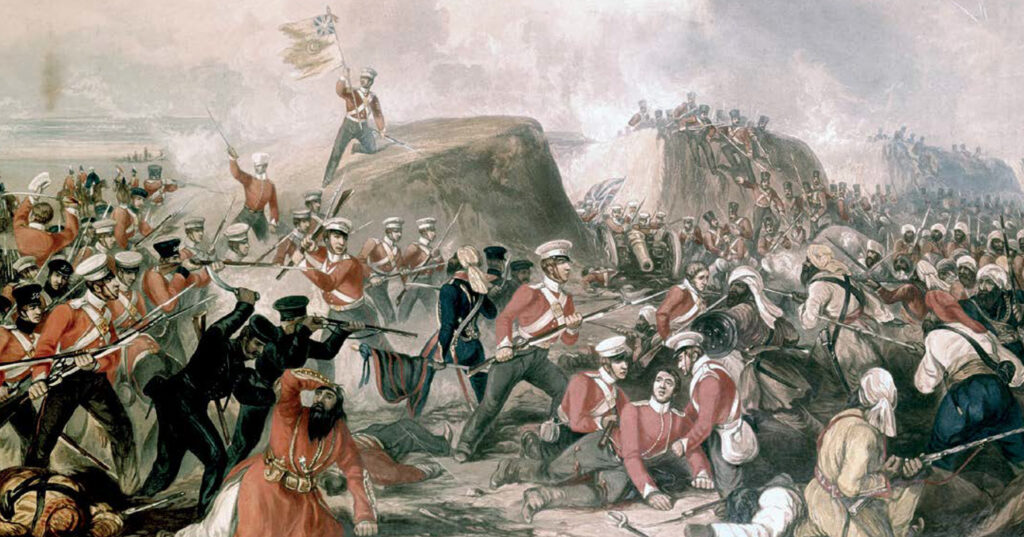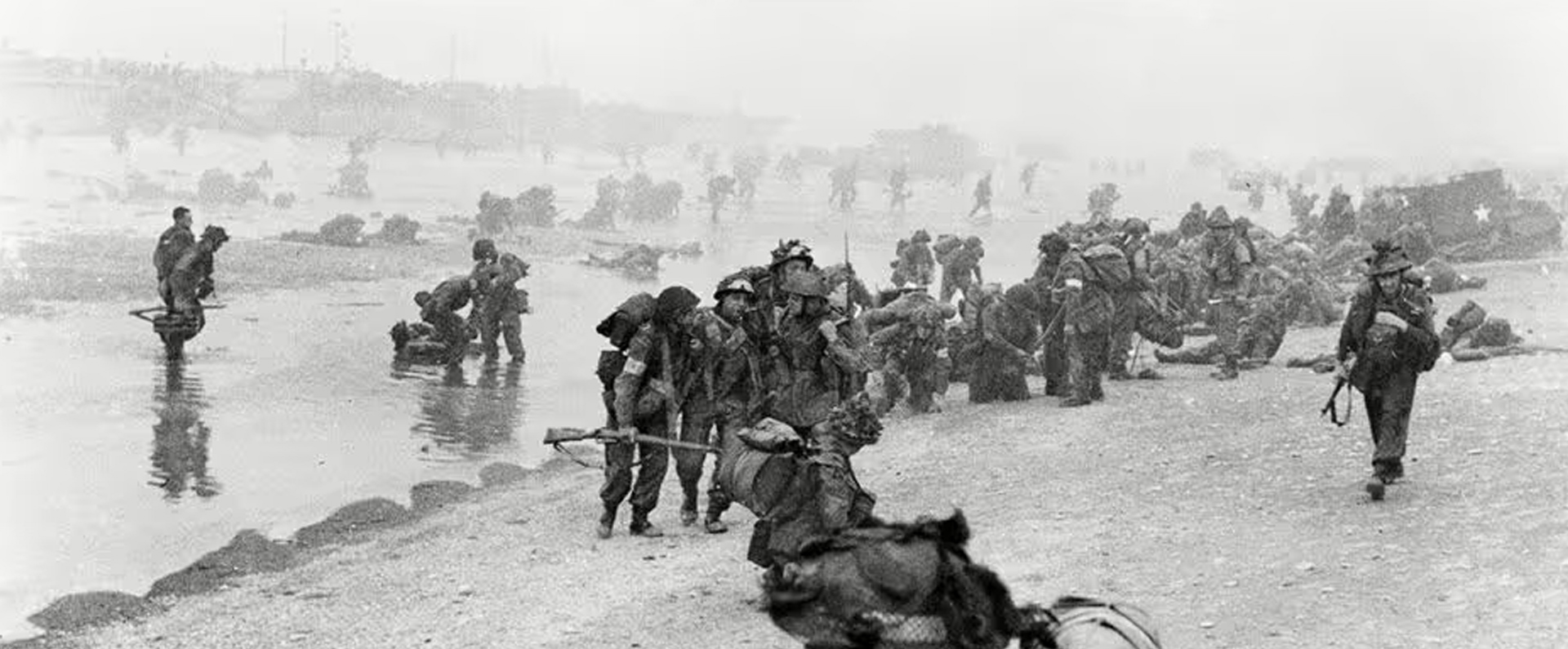
Published in Britain at War in September 2020.
Major-General George Alexander Renny VC
The VC awarded to Major-General George Renny is unique for two reasons: it was to an officer from the only native artillery troop to stay loyal during the Indian Mutiny. Furthermore, it was later stolen and returned to the family five years later as a result of a stroke of good fortune.
George Alexander Renny was born in Riga, Russia (now Latvia), on May 12 1825. He was the son of Alexander Renny, a Scottish merchant living in Riga. However, when Renny was very young, his father died and his mother returned to Scotland with her family.
Renny was educated at Montrose Academy, Scotland, and Addiscombe College, Surrey: the purpose of the college was to train young officers to serve in the East India Company’s private army in India. Renny was commissioned into the Bengal Horse Artillery as a second lieutenant in June 1844. He served during the Sutlej Campaign of 1845-6, when he was present at the Battle of Sobraon on February 10 1846.
In October 1846, Renny was promoted to lieutenant and he spent the next eleven years in India. Renny was married in Naini Tal, India, in October 1849, to Flora McWhirter, the daughter of Dr John McWhirter, who had been president of the Royal College of Physicians of Edinburgh. The couple went on to have three sons and three daughters.
By 1857, Renny held the command of the 5th Troop, 1st Brigade, Bengal Horse Artillery. On May 10 1857, the Great Sepoy Mutiny began at Meerut, and it soon spread throughout the sub-continent: Renny at this time was stationed in Jalandhar, and four weeks later, on the night of June 7, he was first called into action, ordering his native gunners to fire upon the mutinous cavalry and infantry.
There were soon mutinous outbreaks in twenty-six regiments of infantry, seven regiments of cavalry and eight companies of artillery. Yet Renny’s troop remained faithful, as stated the only battery of native artillery to do so. Next, he marched with them to Delhi, arriving in late June only to find that the city had fallen to the rebels.
On July 9, after an attack by the rebel cavalry on the right of the British camp on the Delhi Ridge, it was thought advisable, as a precaution in case they mutinied, to take away the guns and horses of Renny’s troop. The native officers and men begged to be allowed to prove their loyalty, but to no avail, and were placed in charge of the mortar battery on the ridge.
During that evening, their loyalty was again tested when a group of rebels approached and called out to them to join them, and to return to inside the city’s walls. The loyal native Indians replied that they obeyed orders only from their own officers. Instead, they returned to their mortar battery, which they worked and manned without relief until the end of the siege.
Brigadier Nicholson’s Moveable Column arrived outside Delhi in August, and, on September 4, a siege train of thirty-two howitzers and heavy mortars also arrived, along with more than 100 bullock carts of ammunition. This meant that an attack on the rebels, inside their formidably-walled city, was, at last, possible. With the forward batteries complete, the bombardment of Delhi got underway on 12 September. The rebels responded with a storm of mortar, artillery and musket fire that resulted in over 300 British casualties. The battering of Delhi’s defences continued, and on 14 September, the all-out attack finally started.
Renny, then 32 years old, who had been given the command of No 4 Siege Battery, provided covering fire for the initial assault on the city, but casualties were high: on the first day alone the Delhi Field Force lost sixty-six officers and more than 1,000 other men were killed or wounded. However, the primary objectives had been taken, and by noon a solid base had been established from which to continue the attack.
On the afternoon of September 14, taking some of his troop with him, carrying by hand a couple of twelve-pounder mortars, Renny and his men entered Delhi. Once inside the city proper, they successfully shelled several houses that were being used to shelter rebel snipers.
On September 15, the British consolidated their earlier gains, and further artillery fire was directed on to the centre of the city by Renny and his mobile troop. During the night and into the morning of the 16th, the rebels withdrew from the suburb of Kishanganj, leaving behind five heavy guns. These were soon put to good use, and at once a breach was made in the main magazine. A party of the fourth column was ordered to storm it, and by noon the magazine was taken, and with it 171 guns and howitzers, and a vast stock of ammunition.
However, during the afternoon of September 16, the enemy, realising the enormity of their arms loss, made a frantic attempt to recapture the magazine, as well as the workshops adjoining it. Advancing under covering fire, they succeeded in seizing the workshops, and they seemed set to recapture the magazine too.
However, with the outcome of the battle finely balanced, Renny sprang into action. He leapt on to the magazine’s burning roof, and pelted the enemy with shells handed to him, with their fuses already burning. As the enemy withdrew, Renny and his troop turned the mortars captured in the magazine on to Fort Selinghur and the Red Palace, and started a major bombardment, which they continued for the next four days. Finally, on September 20, after five days of fierce fighting, Delhi was taken.
Lieutenant Renny, who was mentioned in General Wilson’s despatch, was promoted to captain in April 1858 and then brevet major in July of the same year. With the city back under British control, he and his troop served in the subsequent operations in Muzaffarnagar District and in Rohilkhund, and their final engagement of the campaign was the action at Sisseah in January 1859.
Renny’s men, whose loyalty had been total and owed a great deal to their commander’s leadership, were singled out for rich praise. Every native officer received the Order of British India, and every Non-Commissioned Officer received the Indian Order of Merit for their services. Furthermore, following Delhi’s capture, the native soldiers had their guns and horses restored to them.
Renny’s VC was, eventually, announced April 12 1859 when his citation ended: “The roof [of the magazine] having been again set on fire, Captain Renny [although he was a lieutenant at the time of the battle] with great gallantry mounted to the top of the wall of the magazine, and flung several shells with lighted fuses over into the midst of the enemy, which had an almost immediate effect, as the attack at once became feeble at that point, and soon after ceased there.” He was presented with his decoration by Queen Victoria in an investiture at Home Park, Windsor, on November 9 1860.
Second Lieutenant (later Colonel) Edward Thackeray, of the Bengal Engineers, who had braved heavy enemy musketry fire to put out the fire on the thatched roof of the magazine at the time of Renny’s VC action, was also awarded Britain and the Commonwealth’s premier gallantry award for bravery in the face of the enemy. However, his VC was not announced until April 29 1862, nearly five years after his action.
In June 1867, Renny was promoted to brevet lieutenant-colonel and the following year he served during the Hazara Campaign on the North West Frontier, as part of the expedition against the Bazoti Black Mountain tribes. This three-week campaign was the last of the sixteen punitive expeditions carried out in the region over a twenty-year period that qualified for the India General Service Medal’s North West Frontier clasp. On 30 July 1868, a tribal force of some 500 tribesmen had attacked the police station in the Agrore Valley, and for the next fortnight the rebels carried out raids in the area.
A punitive force was assembled, and Renny travelled the sixty-five miles from Rawalpindi to the base camp near the village of Koongullee. At 4am on October 3 1868, the force set out from their camp, with Renny in command of D Battery, F Brigade, Royal Horse Artillery. The force had its four nine-pounder guns and two 24-pounder howitzers mounted on elephants. The following morning Renny’s battery went into action against the enemy, who were located on a knoll about 1,000 yards in front of the British position. The enemy was driven off and later in the campaign Renny and his men attacked a redoubt called “Muchaie Peak” which, at 10,200 feet, became one of the highest points that a British force had ever operated. The assault was successful with few casualties and for this role Renny was Mentioned in Despatches by Major-General Wilde, according to the London Gazette of June 15 1869.
Renny eventually retired from the military in December 1878, with the honorary rank of major-general. He died at home in Bath, Somerset (now Avon), on January 5 1887, aged 61. Renny was buried in the city’s Locksbrook Cemetery. There is a memorial in his honour in Freshford Church, Somerset, and his name is listed at the Royal Artillery Chapel, Woolwich, south-east London.
In 1978, Renny’s medal group, including his VC, was stolen during a burglary from the Renny family home in Waldringfield, Suffolk. However, in March 1983, a person using a metal detector on Sheen Common, London, located an unusual object and this turned out to be the stolen Renny medal group. The discovery was subsequently publicised on March 22 1983 and a day later the granddaughter-in-law of George Renny VC became aware of the find and claimed the VC back into the safety of the family.
For several years, the medal group was on display – and on loan – at the Royal Artillery Museum in Woolwich. However, I purchased the medal group at a Spink auction in 2010 and I feel privileged to be the custodian of this brave officer’s gallantry and service medals.
Download a PDF of the original Britain at War article
For more information, visit:
LordAshcroftOnBravery.com


